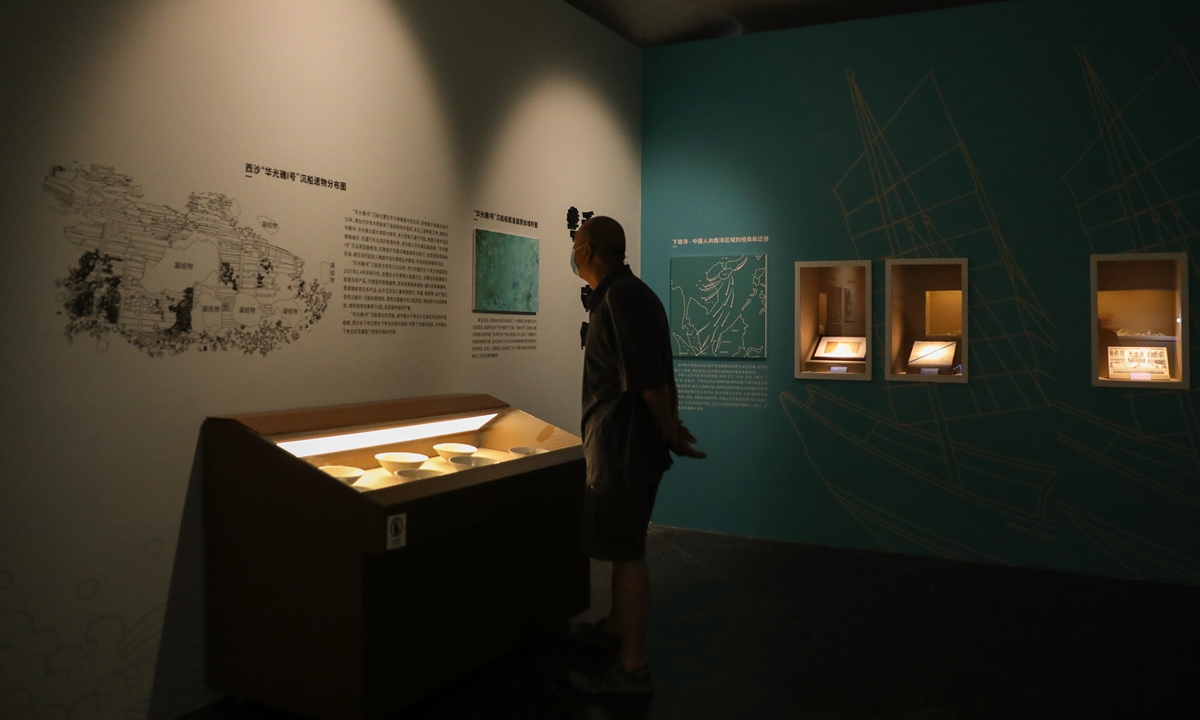Cultural relics from the South China Sea arrive in Mogao Grottoes for the first time
By Ji Yuqiao Source: Global Times Published: 2020/8/17 20:12:49

A visitor is appreciating the exhibition in Dunhuang, Northwest China's Gansu Province. Photo: Courtesy of Dunhuang Academy
An exhibition of cultural relics discovered in the South China Sea kicked off at the Mogao Grottoes in Dunhuang, Northwest China’s Gansu Province, on Saturday. This is the first cultural dialogue between these two key parts of the Land and Maritime Silk Road.
The exhibition was co-organized by the Dunhuang Academy, which oversees the grottoes, and the Hainan Museum in South China’s Hainan Province.
Divided into four sections, the exhibition puts more than 240 cultural relics discovered from underwater archeology sites on display to demonstrate the cultural heritage submerged under the South China Sea in an all-round way and present the long history of the Maritime Silk Road to the public, the Dunhuang Academy said in a statement.
A majority of the cultural relics on display came from a shipwreck dating back to the Song Dynasty (960-1279) that was discovered in 1996 around the Xisha Islands.
The more than 10,000 cultural relics recovered from the wreckage mainly consist of porcelains and ironwares. At the exhibit, visitors will be able to appreciate some of the best porcelain bowls, plates and bottles excavated from the shipwreck.
Porcelain wares are some of the most common wares excavated from the South China Sea, according to the statement. These porcelains come from a various shipwrecks that occurred over the centuries.
Copper coins found on a reef around the Xisha Islands are also on display. More than 100,000 coins have been discovered around the islands.
Among these copper coins, the most recent and the most numerous are from the Ming Dynasty (1368-1644). These Ming Dynasty copper coins were almost all in mint condition, with neat edges and clear patterns. Most of them are linked together with string and could have been part of the cargo belonging to the fleet of the famous mariner Zheng He.
Zheng He was a Chinese mariner, explorer, diplomat, fleet admiral and court eunuch who lived during the early Ming dynasty. Zheng commanded expeditionary voyages to Southeast Asia, the Indian subcontinent, Western Asia and East Africa from 1405 to 1433.
Zhao Shengliang, head of the Dunhuang Academy, said at the opening ceremony of the exhibition that Dunhuang and Hainan are two significant places along the ancient Land and Maritime Silk Road, and as such are carriers of its history.
“Through this exhibition, visitors living along what used to be the Land Silk Road can better understand the contributions of our ancestors to the Maritime Silk Road,” he said.
The exhibition, scheduled to end on October 15, also aims to promote cultural exchanges along the One Belt and One Road.
Posted in: ART,ARTS FOCUS